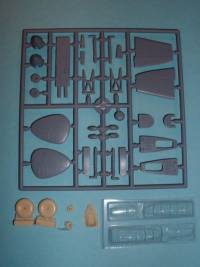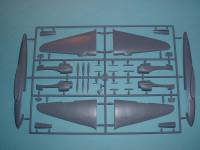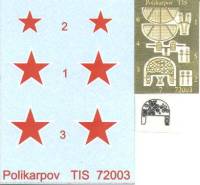| |
|||||
Valom 1/72nd Polikarpov TIS (MA)By Matt Bittner |
 The
request for proposals for a Tyazhelyi Istrebitel Soprovzhdeniya (TIS - heavy
escort fighter) was received by the Polikarpov Design bureau in November 1938.
However, due to other already in-progress airframes the development of the TIS
didn't start until the third quarter of 1940. The first prototype of Polikarpov's
TIS, the "A", finally flew in September 1941. The "A" was
equipped with two Mikulin water-cooled in-line engines, AM-37s. It was only
equipped with four ShKAS 7.2mm machine guns in the nose and two ShVAK in the
wings. Two other ShKAS guns were operated by the radio-operator/gunner who sat
in the rear cockpit. Not only was there a machine gun in the "usual"
position firing from the top of the fuselage towards the rear of the plane,
but there was also another gun the fired under the fuselage that the gunner
could reach by kneeling down in his cockpit. Due to problems with the AM-37
engines and unsatisfactory directional stability, the Polikarpov bureau enlarged
the tail and replaced the AM-37s with AM-39 engines (but due to the unavailability
of the AM-39s two AM-37Fs from the Il-2 program were used instead). In addition,
Polikarpov changed the armament, replacing the four ShKAS machine guns in the
nose with two ShVAK 20mm cannon. While the two ShKAS wing guns were supposed
to be replaced by the 45mm 111P-type cannon with 45 rounds per gun, this prototype
was instead flown with two 37mm cannon. The lower-fuselage ShKAS was removed
but the upper was retained, replacing the TSS-1 mounting with an upper gun mounting
of a VUB-1 bomber, carrying the UBT machine gun with 200 rounds. This new machine
- labeled the "MA" - also differentiated from the "A" by
enclosing the engine radiators in the wings, resulting in openings on each side
of the wing at the leading edge.
The
request for proposals for a Tyazhelyi Istrebitel Soprovzhdeniya (TIS - heavy
escort fighter) was received by the Polikarpov Design bureau in November 1938.
However, due to other already in-progress airframes the development of the TIS
didn't start until the third quarter of 1940. The first prototype of Polikarpov's
TIS, the "A", finally flew in September 1941. The "A" was
equipped with two Mikulin water-cooled in-line engines, AM-37s. It was only
equipped with four ShKAS 7.2mm machine guns in the nose and two ShVAK in the
wings. Two other ShKAS guns were operated by the radio-operator/gunner who sat
in the rear cockpit. Not only was there a machine gun in the "usual"
position firing from the top of the fuselage towards the rear of the plane,
but there was also another gun the fired under the fuselage that the gunner
could reach by kneeling down in his cockpit. Due to problems with the AM-37
engines and unsatisfactory directional stability, the Polikarpov bureau enlarged
the tail and replaced the AM-37s with AM-39 engines (but due to the unavailability
of the AM-39s two AM-37Fs from the Il-2 program were used instead). In addition,
Polikarpov changed the armament, replacing the four ShKAS machine guns in the
nose with two ShVAK 20mm cannon. While the two ShKAS wing guns were supposed
to be replaced by the 45mm 111P-type cannon with 45 rounds per gun, this prototype
was instead flown with two 37mm cannon. The lower-fuselage ShKAS was removed
but the upper was retained, replacing the TSS-1 mounting with an upper gun mounting
of a VUB-1 bomber, carrying the UBT machine gun with 200 rounds. This new machine
- labeled the "MA" - also differentiated from the "A" by
enclosing the engine radiators in the wings, resulting in openings on each side
of the wing at the leading edge.
Only 15 flights were made in the TIS (MA) resulting in a total flying time of nine hours. Damage caused by a brake failure on 29 June 1944 was repaired in a month, but the TIS was ill-fated. On 16 September 1944 the TIS (MA) was damaged again during a belly-landing due to landing gear failure. At this point the aircraft was not restored and the project was stopped.
The Valom 1/72nd Polikarpov TIS (MA) consists of 64 injected plastic, 4 resin, 10 photoetch, 4 vacuform canopies (which includes extras "just in case") and a piece of film for the instrument panel. Decals consist of stars only as it was a prototype.
 The
molding is very nicely done. Valom has come a long way since the Su-6
and I definitely appreciate it. My only complaint is that some of the panel
lines weren't engraved all the way (panel line detail is both raised and engraved)
so there is some panel line rescribing. However, that is my only complaint and
the level of detail is much better than their first offering.
The
molding is very nicely done. Valom has come a long way since the Su-6
and I definitely appreciate it. My only complaint is that some of the panel
lines weren't engraved all the way (panel line detail is both raised and engraved)
so there is some panel line rescribing. However, that is my only complaint and
the level of detail is much better than their first offering.
Although the instructions - at first - might appear to be a little difficult to follow, after reading through them a couple of times it all begins to make sense. In addition, there are a number of "detailed drawings" for some of the subassemblies to show just how some parts are to line up with other parts. For example, when building the cockpit there's a detailed sub-drawing showing exactly how all the pieces are to be fit together and how it should look once assembled.
Naturally construction starts with the cockpit. Once all the cockpit pieces are together the instructions take you into the build-up of both nacelles, building both side-by-side. One item I will deviate from here is the addition of the landing gear. Valom has you assemble these now, prior to adding the nacelles to the wings. Right now - only looking at the kit in the box and the instructions with building it - I would leave the landing gear off until last. Only kit construction will tell all later. Another construction change you may want to make is with the propellers. Valom has you mount the props and spinners to the nacelles also prior to adding the nacelles to the wings. This could make masking very tedious so unless you want the props to turn, I would leave the props off until after final painting. One part Valom brought up to my attention was the lack of spinner "backing plates" within the kit. They recommend adding spinner "backing plates" - from either sheet styrene or filling in the entire spinner with putty - otherwise it will be quite noticeable without these "backing plates".
 Once
that is accomplished then you move into putting the cockpit into the fuselage
halves (as well as other pieces, like the tailwheel well), joining the cockpit
halves together and then adding all of the other major pieces to the fuselage.
When it comes to mating the nacelles to the wings, Valom advises that "something"
happened during the mold-making process, so a little needs to be sanded from
the wing mating edges (of the nacelle) prior to gluing the nacelles to the wings.
Once all of the major pieces are assembled, construction has you add the clear
parts, which is something I advise. That way, if the fit isn't good in
these areas then you can putty them to smooth it all out.
Once
that is accomplished then you move into putting the cockpit into the fuselage
halves (as well as other pieces, like the tailwheel well), joining the cockpit
halves together and then adding all of the other major pieces to the fuselage.
When it comes to mating the nacelles to the wings, Valom advises that "something"
happened during the mold-making process, so a little needs to be sanded from
the wing mating edges (of the nacelle) prior to gluing the nacelles to the wings.
Once all of the major pieces are assembled, construction has you add the clear
parts, which is something I advise. That way, if the fit isn't good in
these areas then you can putty them to smooth it all out.
Valom shows a brown/green scheme on top with blue undersides. I would suspect that with the timeframe the aircraft flew, those colors would be A-21M Brown, AMT-4 Green and AMT-7 Blue. According to Soviet Combat Aircraft of the Second World War: Vol. 2, the color demarcations Valom provides aren't 100% correct. In that book is an excellent port side-shot with a clear view to how the colors were laid out. In addition, there is a frontal, nose-shot of the port side. This means you can accurately portray the color demarcations of the port side of the aircraft. Unfortunately no photos of the starboard side - nor of the uppers - exist in that book, so you might want to follow Valom's outline for those aspects of the aircraft.
This is a very well done model showing that Valom has come a long way in only three kits. While I personally enjoyed building their Su-6 (while others found fault with it) I think the TIS (MA) will be even a better build. Using the tips that Valom sent should pave the way for a better build. You should see a full-build review of this machine in the next few months. Highly recommended, especially if you like Soviet GPW prototypes.
Thanks to Valom for supplying the review model.
Gordon, Yefim and Dmitri Khazano with Alexander Medved', Soviet Combat Aircraft of the Second World War Volume 2: Twin-Engined Fighters, Attack Aircraft and Bombers , Midland Publishing Limited, England, 1999